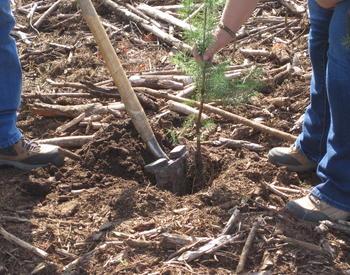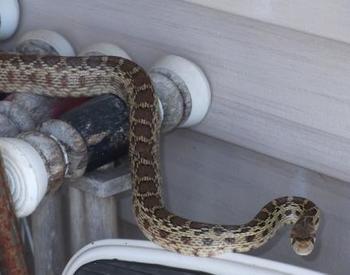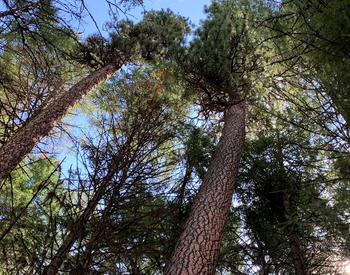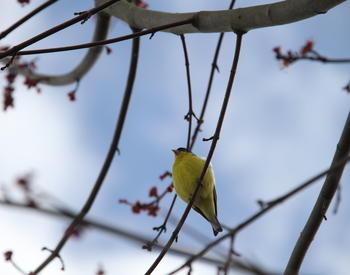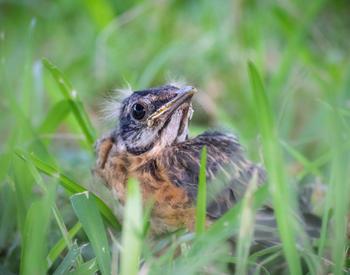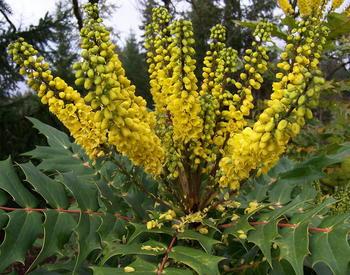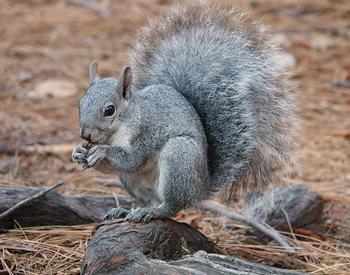Transcript
From the Oregon State University's Extension Service, you are listening to In The Woods with the Forestry and Natural Resources Program. This podcast aims to show the voices of researchers, land managers, and members of the public interested in telling the story of how woodlands provide more than just trees. They provide interconnectedness that is essential to your daily life. Stick around to discover a new topic related to forests on each episode. Hello everyone and welcome back to In The Woods podcast presented by the Forestry and Natural Resource Extension Program at Oregon State University. I'm your host Jacob Putney, assistant professor of practice and extension agent in the college of forestry. This month's episode is going to provide a general introduction to woodland management. We're going to cover a variety of things, but, overall, a look at what forest and woodland management means, why a woodland might need managing?, and using management to accomplish a variety of objectives. We are joined today by my colleague Glenn Ahrens. Glenn is an assistant professor in the college of forestry and an extension agent for Clackamas, Marion and Hood River counties. Glenn is also the director of the Hardwood Silviculture Cooperative. Glenn you've had quite the career in extension, would you like to tell us a little bit more about yourself, your career, and maybe some other projects you've been working on? Yeah, Jake I'd be happy to and thanks for having me on. Well, I grew up in San Diego, California and I early on found myself attracted to mountains and forests and streams that we didn't have nearby. So, I often got out into the backcountry and early on I decided for some reason in eighth grade that I wanted to be a forester of some kind. I worked in a career center, I kind of looked at what that might be. So, I ended up going to Humboldt State University in northern California and then to Oregon State, you know the real uh hub for forestry on the west coast. And got my Master's at Oregon State. And I started out in forestry research, but pretty early on in my career I decided on extension and working with you know helping people use the science and research on the ground that was really my main goal. So, about 20 years ago, I actually got my first job as an extension forester out on the north coast of Oregon and and then I've been over here in Clackamas, Marion, Hood River county territory since 2012. And here when I moved to Clackamas, a really big part of our lives uh here in extension and particularly in Clackamas is the annual Clackamas Tree School. So, a big part of my work and very rewarding part has been helping to put together this Clackamas Tree School every year. And even during COVID times you know as an online series, so, look forward to doing that soon in person. Uh and also and since the 2020 fires you know have burned so much of my territory, but also lots of the west. I've been very busy trying to help people with recovery uh reforestation after fire. And of course a major effort to help people be prepared for wildfire in the future. So, that's what brought me to the present day. Well the eighth grade, that's awful proactive of you I don't think I knew what I wanted to do uh until I got to college really. That's great. So, the past couple episodes that um we've covered here on this podcast have really been laying the foundation in terms of what a woodland is, how they grow, resources they provide, and how they're influenced. But let's talk about the human influence. What do we what do we mean when we say we're going to manage a woodland or a forest? Well management usually involves some kind of an action to direct the course of events, right? And managing a woodland involves taking some action to direct the course of the forest, its growth, its development, uh you know the vision that you might have. How do you reach that? So, it's it's taking an action in order to meet the landowner's goals and objectives. That's the bottom line for what we mean about managing a forest. So, I guess why would someone do that? Why would you need to manage a woodland? And, you know, what might happen if someone didn't manage? Thinking about like active or passive management types or styles. Yeah, and that's that's often a big question a lot of folks might think that forests have been doing fine on their own and can take care of themselves and nature will take its course and we certainly have great examples of uh beautiful forests that haven't been managed with at least not obviously so. So, we often perceive the need to manage a woodland you know when we're not satisfied with the current condition. If you evaluate what you're looking at and, or where you think the forest is headed, um there might be a problem in the future you're worried about you know forest health or something not meeting your objectives. Then you think about intervening about taking action you know to correct that or to to guide the forest to more towards meeting your goals and objectives. Um you know the kinds of things that people might see as well it's a young forest being established and there's not enough trees of the right species. So, I need to plant more trees of a desirable species. You know, the weeds or the brush or unwanted things are taking over so it needs some action to remedy that. Then a few years down the road you have young forest stands that are overcrowded. A lot of folks can see you know patches of trees that look like they're really crowded and perhaps you know stagnating in a way or interfering with you know good development. So, we might want to thin them out, or you look at a patch of trees and you say well there's only one species in that patch and maybe I want more diversity. Or there's not enough daylight on the forest floor, I'd like to see more herbs and wildflowers. So, a lot of things that people might see that they perceive you know to be not the desirable condition and so we want to manage it and change that towards something more desirable. And then you know one of the big things that's on a lot of folks mind is forest health. You know, is this forest headed for trouble, uh we see some trees dying perhaps, um, should we do something? Can we do anything to improve forest health? Uh or particularly you know fire hazards and and concerns about that is often a primary you know impetus for managing for us to reduce fire hazards for example. So, you mentioned the goals and objectives a few times there and I think you alluded to them a little bit, but, um, you know what are the kind of objectives that someone could manage for? And you know how do you decide which ones to prioritize? Yeah, that's a very good question that's often the first uh and hardest part of starting you know a consultation is you know people ask what should I do with my forest oftentimes before they even tell you what they they think they want. And so you always start with well what what are your goals? What are your objectives? Because you have a lot of choices and forests can develop in a lot of different directions depending. Uh you know the kinds of things I think it's helpful sometimes to just make a list or discuss the wide range of possibilities. Ask people what's on their minds, but also give them a list to maybe uh you know give prompt them for some of the things that they might desire. You know, beauty, privacy, recreation, you know. Wildlife, habitat wildlife appreciation, timber value, land investment, a legacy for the future. I just want to be a good steward of the land. I want to keep forests healthy maintaining forest health and being a good land steward is often a real overall goal that many landowners have. Conservation, ecosystem, you know, health and diversity. Those are all the kinds of things you might think about. And then oftentimes the trouble is you know really elucidating those and clarifying what each of those means. Uh and particularly if there's more than one person deciding on the goals and objectives and then of course the management actions. It's important that to reach some kind of consensus or agreement on those primary goals. And those priorities you know what comes first especially when there's a conflict between one goal and another. That's quite the list um another one I was just thinking of is carbon too that's been kind of a hot topic lately of managing the previous investigation things like that. So, what um you're saying is that you know defining your management objectives and your goals is really that crucial first step, but you know what comes next? Say you know say I define my management goals, I prioritize them. Like what do I do next? Where do I start? So, once you do have a set of goals and objectives uh, which may evolve over time but you start somewhere, um then you really need to take stock of the current conditions. And or update your picture of how the forest is doing what you know how it's situated. And that of course you get down into the details. You know, what kind of forest do you have? And as it changes across the land you end up you know identifying different types uh maybe delineating different patches that they have different history, different age, different species. So, really you know taking inventory and and mapping out your current conditions and then adding the idea of how is it going to grow and change because forests don't stay the same they are growing and changing and sometimes rapidly especially in the younger ages when it's really pretty obvious you know over a five or ten year period a lot of change will occur. You have to evaluate those conditions and then kind of match them up with your goals and decide if there's any action needed because in some of those patches of forest they may be just fine and not really needing our intervention so to speak. Uh and this can get really involved if you think about you know many acres of forests and a wide variety of types. Getting to know those types and actually getting them pretty well mapped and taking inventory can be a pretty involved process um as we'll discuss you can get help with that. But it's also you know kind of the pleasure and it's going to take time and you know people that really are love their land and their forest I think they really appreciate taking their time and learning over time. Getting to know the land, the soils, the climate, the growing conditions particularly you know when it's ruled by sort of those extreme conditions. Like the heatwave we just had or like the ice storms or floods or you know the coldest year the hottest year. Those things often really direct the forest development it takes time to see you know how that works as well as the kind of average conditions that you want to know about. So, it takes years and I think the more people learn about their forests and perhaps learn about the challenges, the limitations, as well as those opportunities, you know, they learn new things and they may change their outlook on what's important. So, they might end up going back and changing their goals. So, it's really kind of this we call it a I call the forest management planning circle or cycle. It takes time but it's often quite rewarding. Yeah, I'm just thinking back to our episode on how forests grow and how we talk about the different stand development changes that are um or that's those cycles and how disturbance and things like that influences that. So, I imagine that has an influence on a management cycle as well. So, we have our goals and we have kind of an idea of what we might need to do at each of these stages of forest development. But should we keep record of all of this? And you know how do you keep track of everything?Right, that that can't always stay in one person's head and you can't recall every little detail about that so keeping records can be very important. Um you know as I was mentioning some of those elements of what would be nice to know you know about the different patches of vegetation and where are they? And what are the boundaries? How many acres is it? And what's inside of it? You know, how many trees? What kind of trees? You know all that information pretty soon is going to be an overwhelming amount to just keep in one's head. It's surprising how many people do just have it all in their head and don't have it written down or even mapped that well, but clearly when it comes to looking at acres and the diversity of forests across the acreage. Having the maps, the photos then the written documentation and or stored on a computer. You know it's going to be really essential for keeping track of all that. And then if you think about the uh over time the changes that are going to occur. Well if you start now with one part of your forest that's you know being established in the sort of zero to ten year age class well, 10 or 20 years go by um, how did it start? Where is it going? What's its current condition? And you need to update those records obviously. So, that's where you know a good written plan and also more and more the computerized records uh the mapping and and data management tools that we have on our computers or even on our cell phones these days are really helpful for keeping track of this kind of information. And if you think about it you know not only for your own sake if you are the uh you know the decision maker let's say, but clearly for others, for your consultants, for your family, for you know the rest of your co-owners, if you're in a group you know it's going to be essential to have have a good track and good record keeping. Yeah, yeah I try to take notes on everything and thinking about um doing an entry or some type of management every 10 to 20 I couldn't remember what I did 10 years ago. I mean your forests on the the west side go a little bit faster than ours over here on the east side of Oregon but um still still I think keeping records is a really great idea. So, it really sounds like there's a lot of moving parts and thinking about what your management objectives are, your goals, prioritizing them, taking some sort of inventory or look at what different forest types, composition structures are on your forest, and then kind of coming up with a plan to the management to meet those objectives um. It sounds like there's really a lot of moving parts. So, really who could someone go to if they wanted help in determining if they need to manage or developing a plan or identifying some of their goals and objectives? Well I could be biased I think a great place for people to go for help is their extension forester. And part of the reason I say that is because our job is really to be an objective and educational consultant. And to help people learn what they need to learn to be able to make a good decision. And once they have, then they can know better when do they do things themselves? You know what's within their capabilities to take care of uh when would they hire a professional? What kind of professional? What questions you ask when you're looking for the right professional to help you with you know with mapping or inventory a timber cruise? An appraisal? Um looking at maybe doing some harvesting or marketing. What about roads? How about consulting about your streams and your fish habitat? I mean there's so many different interesting and also challenging aspects of managing forests. And there's a lot of great expert advisors out there. And some of them for a fee and some of them are free. But you know starting with extension we can really help people kind of figure out where to go next and what they can do themselves and who they might like to hire. And then when you get down to that work that's involved you know making good maps, getting good aerial photos, being able to kind of map out where your different types of forests are, figuring out the acreages. You know, the details of what kind of inventory, how good does it need to be within a forest type? You know, especially if there's really high values at stake: timber value, wildlife, habitat, roads those kinds of things. Then there you know there's going to be some really key decisions for someone to make about hiring a professional to help. And outside of our their extension forester, as far as public assistance, uh paid for by your tax dollars. You could look towards the Oregon Department of Forestry uh again a great resource and they do slightly different kinds of things and get more into the details of technical forestry, and also uh you know the laws and the rules. Soil & Water Conservation Districts, which vary county to county, but often are just a wealth of good sources of assistance. And here in my county a lot of times you can sit down with your Soil & Water Conservation District person and they can you know help you map this out and help you get a good set of uh you know overlays of topography and streams and roads and air photos and things which you know is easy enough to do on your own these days on the internet, but it's nice to sit down with a professional that's good tools it can help with that. The USDA Natural Resource Conservation Service and then of course you get to hiring professionals like forestry consultants and forest practitioners you know forest contractors that do planting and management all that. But we kind of start out you know providing guidance for, you know, when you need that? What should you expect? And how do you go about hiring the right people? One thing you mentioned that I didn't really think about just yet was um the Oregon Forest Practices Act. And um it sounds like the stewardship forester or the Oregon Department of Forestry could really help out with that but, um, what kind of things might be in the Oregon Forest Practices Act that would affect like management? Or your management plan, for example. Yeah, I mean it's certainly it provided the Oregon Forest Practices Act and the rules derived from the law um are really the uh kind of the the backdrop and the uh you know the boundary of minimum standards for protecting public resources. You know, fish, wildlife, air, water. Uh some of those public benefits of the forests that you know may be private forests that we're managing for our own objectives. And then those rules you know, not only are they a backstop or a standard, they they also provide assurance to the public that people are doing a reasonably good job of protecting the forests and the resources. So, you know that's one aspect of that. Working with with the department of forestry you know they will give you specific advice and their goal is to help you understand those rules and comply with them. But they're also there to help you just meet your own objectives you know with the rules kind of as a backdrop. There's a nice resource that is useful for kind of understanding where these rules come in you know because they apply to any kind of timber harvesting operation you know. Especially protecting streams with you know buffers and riparian areas, uh applying forest chemicals, uh use of fire, use of power tools, especially during fire season. Um you know there's a lot of different aspects of forest management that um come up against you know the rules. There's the illustrated uh forest practices the Oregon forest protection laws the illustrated manual which is a nice resource that you can go to without having to you know call the forester right off you can just read it and look at it in a nice visual you know description of the forest practice rules and where they apply. So, I certainly advise people to go to that and you can get a hard copy of that as a book too which is real nice as well as seeing it online. Yeah, I really like that illustrated guide. I always keep a copy of it somewhat handy so I can reference it especially if folks have questions. We did touch on the uh stream rules a little bit in the water episode that was a couple episodes ago but um there's definitely a lot more information in there and I think it might be on our website. But if it's not I'll make sure to get that on. But uh speaking of resources, you know, what other resources someone used if they wanted to learn more about management or planning or things like that? Well certainly delving within our Oregon forest management planning resources extension and the other partners in forestry education particularly department of forestry. Also, I should mention the Oregon Forest Resource Institute has a lot of resources and does a lot of work on educational resources for woodland owners. Um so you know we put our heads together and we have a nice website right now that we can direct people to that really guides you through kind of the steps of you know getting to know your land and working on your goals and objectives and then getting down to the details of uh forest management planning. So, that you know that's a good online resource. Another great way just to learn as you go and what we're big on in extension is is getting people together with other experienced woodland owners. You know, often partnering with the Small Woodlands Association in Oregon your local chapters uh through the Oregon Tree Farm System. And there's other opportunities you know groups getting groups of folks together that have been taking care of forests and sharing and learning from each other is a great way to learn more about forest management. And then also we have an extension we have master woodland managers who are really the more motivated and kind of public service oriented uh woodland owners who not only learn for themselves but they want to share with their neighbors and other woodland owners so you know what they've learned and so we have trained volunteers as well to help. Um I do I don't think there's a good substitute for really getting together on a field tour or a demonstration or a workshop and having a range of experience, so not only a professional educator like myself or a forester, but also then having you know a diversity of woodland owners who have maybe different perspectives and sharing what they've done and what worked for them and what didn't and uh how they solve their problems. Yeah, absolutely I agree I think that's gonna be great. And there's always the internet. A lot of our resources are on the internet. Speaking of the internet I mean the tree school online there was a ton of different uh webinar episodes that are still available online and it covers a wide variety of topics for non-timber forest products you know the taxes and everything else in between. Right, and I certainly direct I can't quite separate myself from the internet these days spending so much time on my computer when I'd rather be out in the woods but more and more of our good educational material is being produced and delivered via the internet um. But of course there's a lot of other information on the internet and not all of it is credible or based on uh you know good information, so certainly want to i would tend to direct people towards credible sources and certainly in extension we strive to be one of the good credible sources of information and we have lots of good stuff online. But there's plenty of other organizations that have credible information online as well that people can learn from. Yeah, definitely. Well thank you so much for joining us today Glenn uh management just really includes so many different factors and as this podcast move forward, and we're going to try to touch on each of them in more detail, but uh we hope you got a sense of the basics of what it means to manage woodland um don't hesitate to send us a comment or a question about this month's episode especially if something came up as you were listening that you'd like to hear more about. The best way to reach us is at our website at inthewoodspodcast.com. Glenn, I know you're an expert on this so we might have to bring you back on to cover some more. But before we finish this episode we can't forget to do what we are calling our lightning round or where we asked a few questions of our guests. So, Glenn first question here you know what is your favorite tree? So, first I have to think about are you talking about one tree? A particular tree? Or are we talking about a species of tree? But I'm going to take liberty and do both. Um, so a favorite tree is it's actually a Pepper Tree that my parents planted about the time I was born and we grew up together. And it grew faster than I did and I was climbing that tree as a youngster and falling out of the tree and it got pretty tall pretty quick. And to my knowledge it's still healthy still growing over 60 years later so that that is one tree that stands out in my mind as a favorite tree. Then I have to say as a forester and particularly for my life long experience in the forest you know Douglas fir has played such a big role in my life as a forester and I've been a west coast forester primarily. Um really haven't practiced forestry further east than um than Idaho, Montana. So, a Douglas fir has always been there in most of the forest. And it has so many forms from you know north to south, coast to mountains. I've seen it down near Mexico and up deep in British Columbia in the far north uh. I've seen 10-foot diameter trees that were 900 years old. Amazing plant plantings of Douglas fir even in my life they're 40 years old and becoming a forest so I'll pick Douglas fir as my favorite species. No, I think that Douglas fir is really just an iconic species here in the pacific northwest and has such a wide range and such a variety of conditions that it grows. But it's interesting that you bring up your favorite tree not a favorite tree species. I haven't had anybody uh comments on that before I'd have to take a minute and think about what my favorite tree is that would be hard to pick just one. But um but anyways we'll move on here to our second question, so what is the most interesting thing you bring with you in the field? Uh whether in your cruiser vest or other field kit? Well I think that I put too much thought into that my first response was you know one of the tools in a cruiser's vest. So, I thought well the increment core that's a pretty neat tool because you can you can core tree and and look into the past and learn a lot about how a tree has grown over its life and what's happening to it recently good times and bad times. But then I thought harder about it and I said well the thing I bring to the woods that's most interesting is an inquiring mind. And struggling to be you know open to learning. So, sometimes you get set in your ways and you may not be open and you just look at things the same old way and see the same old things especially when you go back you know to doing the same thing for 40 years like I have. Um so better yet not only with my mind but to bring a companion with me that has it maybe a different perspective to see things differently and help me learn new things. So, that's what I want to bring into the woods. I think that's a really good one Glenn. I sometimes you know I got to see the forest for the trees sometimes I'm in the woods with the an objective. i'm trying to work on something and I need to take a minute to think about what's around what's really going on. Uh the last question here is about resources. We've covered a lot of them already, but is there anything else that you would recommend to our listeners to check out if they're interested in learning more about woodland management or planning or anything in between? Um you know I think digging deeper into the knowledge that's out there in the different fields. You know I was we were talking about water quality or stream protection rules or you know effects of wildfire, climate change. So, really exploring especially starting with the internet but maybe finding people that there's so many great ways that people are telling stories and really articulate and well-researched and fascinating stories out there with a lot of good visuals. So, look for those things maybe through the university or through other kinds of learning uh institutes. There's a lot of nonprofit groups um you know a lot of them have different agendas, but um you kind of read their opening web page and then kind of see what they're at and then they have a lot of great uh stories and visuals. So, I exploring there. But then maybe finding some people. Like just the other day I was researching uh forest recreation you know and how do you value the recreational aspects of forests. And who's I haven't really looked at that real hard lately I've kind of been focused on woodland owner education a lot for maybe a long time. And you know I found a paper by Randy Rosenberger all about forest risk uh you know recreation values and really extensive research on trying to understand the value of forest and people uh for recreation and and health and peace of mind is, anyway, just found a whole bunch of new resources and I emailed uh him and he sent me a lot of great links to new things. So, find the people and send them an email or give them a call and ask them about it at OSU or any any other you know institution for education. Yeah, yeah that's great that's a really good tip plan. Well all right everyone uh this is going to conclude this month's episode. Glenn thank you again so much for joining us today uh and we will see you all next month, take care.
Thank you so much for listening, show notes with links mentioned on each episode are available on our website inthewoodspodcast.com. We would love to hear from you, visit the tell us what you think tab on our website to leave us a comment, suggest a guest or topic, or ask a question that can be featured in a future episode. And also give us your feedback by filling out our survey. In The Woods was created by Lauren Grand, Jacob Putney, Carrie Berger, Jason O'Brien and Stephen Fitzgerald who are all members of the Oregon State University Forestry and Natural Resources Extension Team. Episodes are edited and produced by Kellan Soriano, music for In The Woods was composed by Jeffrey Hino and graphic design was created by Christina Friehauf. We hope you enjoyed the episode and we can't wait to talk to you again next month. Until then, what's in your woods?
In this episode, Jacob Putney discusses the importance of managing forests with Glenn Ahrens. Ahrens is an assistant professor for Oregon State University's College of Forestry and extension agent for Clackamas, Marion, and Hood River Counties.




